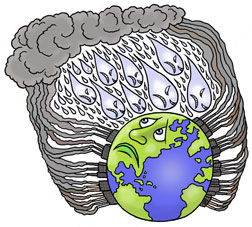Whatever Happened to Acid Rain?. Why do we never hear about acid rain anymore? Did it just go away?. Back in the 1980s, when the Lantern herself was just a little penlight, acid rain was the environmental scourge of the day.
Canada's environmental minister proclaimed it an "insidious malaria of the biosphere"; it menaced the Transformers; it turned Kimberly's hair bright green in an episode of Diff'rent Strokes. Toxic precipitation fell off the radar in 1990, when Congress passed an amendment to the Clean Air Act calling for major reductions in the types of emissions that lead to acid rain. Emissions have dropped significantly since then, but the problem is far from gone.
Acid rain occurs when sulfur dioxide and nitrogen oxides—gases released by the burning of fossil fuel—form acidic compounds in the atmosphere. These fall back to earth in rain, snow, or sleet or as dry particles or gases. (At high altitudes and along coastlines, bits of acid suspended in clouds or fog pose an additional threat.)

Back in acid rain's heyday as a public menace, scientists focused on how it wrecked lakes and streams, making the water toxic to fish and other organisms and threatening sensitive tree populations like the red spruce in the Northeast mountains. In later years, they began to understand how acidification can also cause imbalances in soil chemistry, exacerbating problems for watersheds and plant life.
The results of these efforts were dramatic: According to the National Emissions Inventory, sulfur dioxide emissions from all sources fell from nearly 26 million tons in 1980 to 11.4 million tons in 2008. Nitrogen oxides decreased from 27 million tons to 16.3 million tons in the same time frame.
Problem solved, right? Not so fast. Rain in the eastern United States is still relatively acidic. As you can see on this map from 2007, most rainwater in the region has a pH level between 4.3 and 4.8. (In the late 1970s and early 1980s, annual averages in the East were closer to 4.0.) According to Gary Lovett of the Cary Institute of Ecosystem Studies, the natural pH level for rainwater in the region would be around 5.2. That might not seem like a big difference, but remember that pH is a logarithmic scale, not a linear one, so something with a pH level of 4 is 10 times more acidic than something with a pH level of 5. In short, much of the rainwater in the East is between 2.5 and eight times more acidic than it should be.
Meanwhile, surface waters are showing slow signs of recovery, but not in all areas. In the Adirondacks and Northern Appalachians, one-third of the bodies of water deemed acidic in the early 1990s can now be taken off that list, according to a 2004 EPA-funded report (PDF). There are now 70 percent fewer acidic lakes and streams in Wisconsin and Michigan than there were 1984. However, the report found no changes in New England or the Valley and Ridge and Blue Ridge provinces of Virginia, two other areas with a history of acid-rain damage.
Decades of industrial pollution have also compromised the soil in some areas—which might under other circumstances buffer local trees, lakes, and streams from the harmful effects of acid rain. (Healthy soil provides alkaline components, primarily calcium, that neutralize the acid.)
Interest in acid rain seems to be experiencing an uptick in the last few years. The EPA issued the Clean Air Interstate Rule in 2005, which set even lower emissions caps for power plants in the eastern United States. (The rule was tossed out by a federal appeals court last summer but has been temporarily reinstated until the EPA can draft a replacement.) The EPA is also currently reviewing its secondary air-quality standards for sulfur dioxide and nitrogen oxides—i.e., those that address "public welfare," including ecological damage, as opposed the ones pertaining directly to human health. And in Congress, Sens. Tom Carper, D-Del., and Lamar Alexander, R-Tenn., have teamed up to present a bill that would call for even further reductions of SO2 and NOx—as well as mercury—from coal-fired power plants.
A recent joint report (PDF) from the Nature Conservancy and the Cary Institute also stressed the importance of setting and implementing critical loads for SO2 and NOx, as well as establishing more comprehensive, integrated air pollution monitoring systems.
Still, efforts to reduce emissions of acid rain precursors in the United States don't do much to solve the problem in countries on the other side of the globe. In 2005, China was the biggest emitter of sulfur dioxide in the world, sending up about 25.5 million tons. Beijing did recently announce that, by next year, the country would reduce SO2 emissions by 10 percent from those 2005 levels. Two-and-a-half million tons is more than an acid raindrop in the bucket, so at least that's a step in the right direction. ( slate.com )
No comments:
Post a Comment